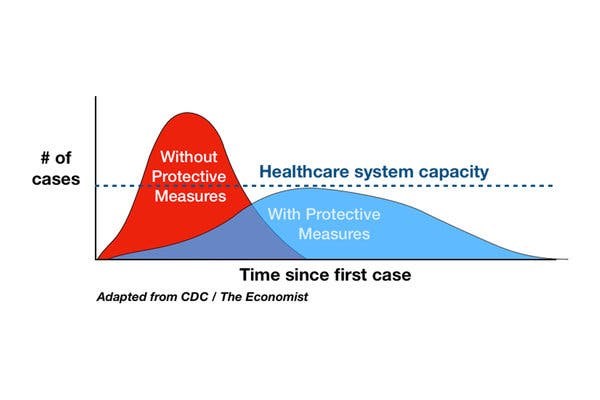News
Bob’s Blog: Lead By Shutting It Down: Notes on COVID-19
There are three things on my mind this morning: Italy, Flatten The Curve, and Social Distancing.
In less than one month, our entire world and daily lives have changed, and the culprit is COVID-19. The World Health Organization has just declared that we are now in global pandemic status. In a pandemic, fear, anxiety, and helplessness can reign and dominate the civic landscape. But we still have some control – institutionally and individually. We must exert it.
Let’s start with Italy. COVID-19, also known as the novel Coronavirus, has overwhelmed parts of Italy and reports are that the capacity of the health care system has been significantly compromised. The sheer number of cases requiring medical attention and support has swamped the capacity of the health care system to respond. Nightmare-like scenarios of patients in hospital hallways and a lack of needed medical equipment and ventilators have emanated from parts of Italy. Obviously, when this point is reached, death and suffering from the spread of the virus becomes more rampant, particularly in at-risk patients, vulnerable populations, and the fragile elderly.
This is the place that we (in LA, in California, and in the U.S.) must assertively, scrupulously, and diligently avoid.

In the absence of a vaccine to immunize our communities from spread – and especially with spotty or inadequate testing kit capacity — we must do whatever we can to “flatten the curve” on spread of those with virus. “Flatten The Curve” means slowing the steepness of the rate of spread, with the intent of remaining within the capacity of the health system to treat those who are in need of medical attention and care. As the New York Times recently noted from a CDC report, a more gradual rate of infection over a longer period of time results in fewer people infected and a reduced number of deaths. It also provides, as the Times states, “our doctors, hospitals, police, schools and vaccine manufacturers time to prepare and respond, without becoming overwhelmed.”
The best tool at our disposal – individually, organizationally, and societally – is “social distancing,” the act of creating space to reduce viral spread.
By now, we have all heard about the commonsense measures of frequent use of handwashing and hand sanitizers, and “elbow bumps” rather than handshakes or hugs in greeting friends or colleagues. But we all need to take responsibility for shutting down the gathering of humans for meetings and in the workplace to the greatest extent possible in the coming weeks. We must work from home whenever and wherever possible. That “really important” conference or planning meeting you have scheduled for next week? Trust me, not so important at this moment. That great concert you were looking forward to, the tickets to the ballgame, the trip for the kids to the theme park? Shut it down. We all must serve as an extension of our public health department through the practice of social distancing. It won’t be forever — let’s just take it a few weeks at a time.
The more we can “social distance”, the more we can “flatten the curve.” The more we can “flatten the curve”, the more time we can provide to get out of flu season, provide time to improve the testing kit situation, to get to warmer weather, provide time for our hospitals and medical professionals to prepare, and to buy more time for a vaccine to be developed. So work from home, allow staff to work from home, dispense with the need for doctor’s notes for sick days, take meetings by phone or just cancel them altogether, and – of course – if you’re sick, don’t be a hero and show up to work to demonstrate how committed or tough you are. Just shut it down and stay home.
A note to colleagues in the field of philanthropy: Aside from “modeling social distancing to flatten the curve”, we can and must turn our attention to the most vulnerable, the most fragile, and the anticipated needs of the nonprofit sector who serve the most vulnerable. This could mean:
- Turning existing program and project grants into operating support for grantees.
- Encouraging grantees and nonprofits to cancel the annual dinner as the fundraiser – and provide the financial sponsorship support anyway. You’ll miss the chicken and mashed potatoes dinner, but just mail the darn check.
- Recognize that service industry workers and their families (disproportionately from immigrant communities) will be hardest hit. Create or contribute to funds established to provide them with support.
- If you are not yet thinking about responding to the needs of the homeless population, start now. Coronavirus spread in homeless encampments and shelters constitutes a public health nightmare. It will not be pretty.
- Call your local or state public health-officer and ask him or her how we might be of assistance. Public health officers and departments are beleaguered and over-taxed right now.
Flatten The Curve. Social Distancing. Shut it down where possible. Do action without in-person meetings We must all lead. Now.
We are advancing
health and racial
equity in California

Health Systems
Health Systems
Our health system works best when every Californian has access to quality and affordable health care.
Learn More
Justice Reinvestment
Justice Reinvestment
Re-imagining a criminal justice system that centers on prevention and healing.
Learn More
Inclusive Community Development
Inclusive Community Development
Our communities and neighborhoods thrive when policies advance health and racial equity for all Californians.
Learn More
Power Infrastructure
Power Infrastructure
Building Power in resilient communities across the state for a stronger California.
Learn More
Schools
Schools
Academic achievement, inclusive learning environments and health go hand in hand.
Learn More